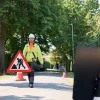Vodafone Push 5G Broadband Speeds to 5Gbps via Upper 6GHz Band

The tedious debate around whether EU and UK regulators should release the upper 6GHz radio spectrum band for use by WiFi or Mobile networks (or share it between both) has taken another twist after Vodafone conducted a new test, which used the band to achieve 5G mobile broadband downloads of “up to” 5Gbps (Gigabits per second).
Just to recap. Ofcom has already made the Lower part (5925 to 6425MHz) of this band available for WiFi in the UK under WiFi 6E and beyond (here), but the Upper part (6425 to 7125MHz) remains the subject of debate. Mobile operators want to harness it (licensed) to deliver faster 5G based mobile data speeds, while others say it should go toward licence-exempt WiFi. Both have a need for more capacity to keep up with demand.
The issue is due to reach somewhat of an international climax next month at the World Radiocommunication Conference (WRC-23) in Dubai (UAE), which will help to decide the future use – internationally – of this valuable spectrum resource. Regulators often follow what the bulk of countries decide to do, thus helping to maintain as much harmonisation as possible, although Ofcom still has plenty of flexibility in this regard.
Advertisement
Vodafone has now attempted to demonstrate the sort of difference that releasing the Upper 6GHz band for mobile network operators could make with a new test, which was conducted in Spain using a 200MHz channel of spectrum frequency (roughly what operators expect to get if regulators were to release it). The operator claims that this test achieved download speeds of “up to” 5Gbps, albeit falling to around 2Gbps for indoor locations. The test also harnessed Massive MIMO antenna technology to help “beamform” signals in the direction of individual users.
However, it should be highlighted that this test was only run over fairly short distances – on an uncongested link – at Vodafone’s campus and the surrounding area in Madrid, and the indoor speeds of around 2Gbps were measured in relatively modern glass fronted offices. The speeds then dropped to around 0.5Gbps when reaching public buildings as far away as 550 metres. But then bands like 6GHz, on a mobile network, are definitely more intended for dense urban areas than wide open rural spaces (higher mobile frequencies don’t go very far before interference wrecks performance).
The results were very good, albeit in ideal circumstances (real-world deployments would be slower), and helped to demonstrate that the 6GHz band can both penetrate building façades and pass through them. But none of this will be a surprise to decision makers, as it’s already possible to predict such performance. But at the same time, WiFi needs to feed a growing market of multi-gigabit fed FTTP broadband equipped homes too, which it currently struggles to achieve.
Alberto Ripepi, Vodafone’s Chief Network Officer, said:
“Without a fair and balanced allocation of 6GHz spectrum, mobile users worldwide could face a major capacity crunch within just five years. Additional 5G spectrum would boost the digital transformation of businesses and public sector organisations, and support the European Commission’s ambition to have fast connectivity within reach of all populated areas by 2030.”
The reality here is that there’s only a finite amount of radio spectrum to go around and so, as mobile technologies evolve, then there will inevitably come a point where the only way to expand coverage and still deliver improved speeds will be to build increasingly dense networks – using bands in ever higher frequencies where there’s more spectrum to go around for data.
Advertisement
Ofcom has also recently been exploring whether a hybrid approach might be the answer (here), where the Upper 6GHz band is shared between both WiFi and Mobile networks. But Vodafone cautions that “this would only be possible if significant restrictions were imposed on mobile base station power levels, sacrificing the performance benefits for customers” (necessary to avoid causing interference in a co-existence environment).
Personally, we tend to favour simplicity over complexity in these things, as complexity tends to add costs and other problems (e.g. see ‘TV White Space’ broadband technologies for an example). In that sense, we’d rather see the Upper 6GHz band go to either Mobile or WiFi, rather than being shared, but hopefully WRC-23 will help to answer this long-running debate.
Mark is a professional technology writer, IT consultant and computer engineer from Dorset (England), he also founded ISPreview in 1999 and enjoys analysing the latest telecoms and broadband developments. Find me on X (Twitter), Mastodon, Facebook, BlueSky, Threads.net and Linkedin.
« Full Fibre Broadband Operator Toob Opens New Office in England






















































WiFi has far less spectrum available, so IMO upper 6GHz should be used for WiFi. If more spectrum is required for 5G then operators should lobby to be able to use parts of n79.
WiFi use is localised and mostly indoors so less spectrum needed. The 6e spectrum gives plenty to work with for now and even then range isn’t great. Better mobile networks get the capacity outside of isolated cases like stadiums and can’t split the spectrum allocation easily depending on location.
> The 6e spectrum gives plenty to work with
I’d have to respectfully disagree. The current 6GHz spectrum in Europe (5,925 MHz to 6,425 MHz) is helpful, but it’s not really big enough to make the most of WiFi 6. There’s only enough spectrum for 3 non-interfering 160 MHz channels, whereas elsewhere they have enough spectrum for 7. Looking ahead to WiFi 7, there’s only enough capacity for a single non-interfering 320 MHz channel with the current European allocation, whereas elsewhere there’s enough capacity for 3 320 MHz channels (source: https://www.wi-fi.org/system/files/202103_Wi-Fi_6E_and_6_GHz_Update.pdf).
That’s a really useful resource Ben!
The new spectrum for wifi 6E is a big upgrade today, but it is clearly obvious that it’s a resource that will run out quickly.
In the face of evidence I’m happy to stand corrected as far as needs go and admit it’s nowhere near as simplistic as I made it. Thank you!
They need to release it for home ISPs to use for our home WiFi networks. The mobile operators already have plenty & they are even going after the bands that DTTV use, mostly looking at the 600mhz range target then the full 450-690mhz. Plus with mmWave auction coming next year the MNOs will have even more.
The US is using this band to amazing effect for hight speed FWA broadband. Delivering 1 Gbps to rural and suburban locations using Tarana equipment is a much more economic fix to broadband woes than fibre. The UK should encourage the same over here. Fibre altnets are failing to build and attract customers, so we need something faster and more economic to deploy.
We have way more altnet fibre build than the USA and way more competition at retail and network level. They’re also way more spread out than we are, no PIA, tons of poles needing local authority permission, franchise agreements locking altnets out, etc.
There’s no reason for us to follow the USA’s lead here. Our suburban areas should get FTTP in time, all of them, and very few of our rural areas are so expensive Project Gigabit won’t cover them.
Vodafone needs to at least upgrade their existing network first! 5G coverage sucks and 4G speeds are getting considerably worse.
I can’t believe. Vodafone’s arrogance on this matter.
The MNO’s aren’t even using anywhere near the spectrum they already have and yet they are arguing to secure more.
5g has been an utterly overhyped technology which has failed to deliver any significant value or compelling use cases.
The network vendors Nokia, Ericsson, have been far too greedy with their pricing. The MNOs have barely even managed to leverage 5g to add any significant capacity due to a lack of investment on their part.
6ghz spectrum is not even suitable for long range usage and why on earth do mobile devices need speeds of several Gbs.
Nearly all devices spend the majority of their time on Wi-Fi networks. And thank goodness they do as without that Wi-Fi offloading, the mobile networks would become utterly choked.
Wi-Fi is the most successful wireless technology and for good reason. But with all the high capacity fibre being deployed everywhere now, it’s only as good as the Wi-Fi deployed at the end of it Wi-Fi need 6ghz to deliver high capacity wireless connectivity and as has been proven in the US, it’s already proven to be incredible successful and has an established eco system of 6ghz devices now.
The way Wi-Fi is evolving and being deployed it is outperforming 5g. This will become even more pronounced with Wi-Fi 7.
You can even deploy Wi-Fi 6ghz with led street lighting luminaires now where you can effectively cover an entire town centre or outdoor are with blanket ubiqtous Wi-Fi mesh at 6ghz, for a fraction of the cost and complexity as 5g standalone.
Mobile network operators should focus on fully utilising their existing allocated spectrum and deploy better ubiqtous lte/5g coverage than trying to reserve yet more spectrum.
Upper 6GHz is important for the evolution of 5G and delivery of high capacity in urban areas. These midband frequencies are essential for mobile and would be wasted on short-range communications like Wi-Fi where mmWaves are better suited.
Except the opposite is being proven to be reality.
Wi-Fi at 6ghz is thriving in the US which has adopted the entire band.
Public space Wi-Fi is having a massive resurgence.
The device ecosystem is thriving.
In contrast, 5g is failing to deliver any of its promises whatsoever. Moreover, it appears that to even come close to deliver on any of its promises there will need to be a huge investment by the MNOs to des sofy their networks on a scale never seen before. Who’s going to pay for that when Wi-Fi is already capable of delivering that densification.
The benefit of 6GHz for 5G is precisely to avoid densification. And the allocation of the upper 6 GHz to Wi-Fi in the US was one among a series of poor decisions by the FCC. Mid-bands are essential for mobile (as now acknowledged by FCC), and high bands (mmWaves) are better suited for short range communications like Wi-Fi. Radio engineering 101.